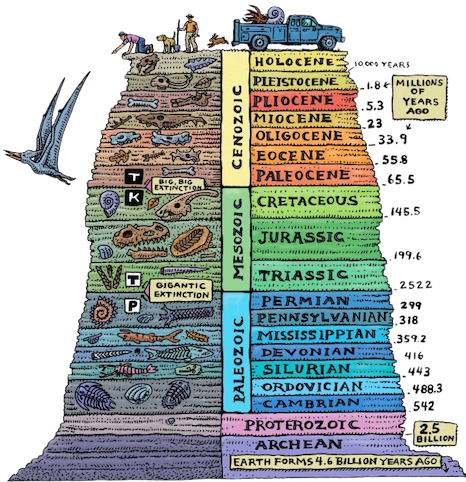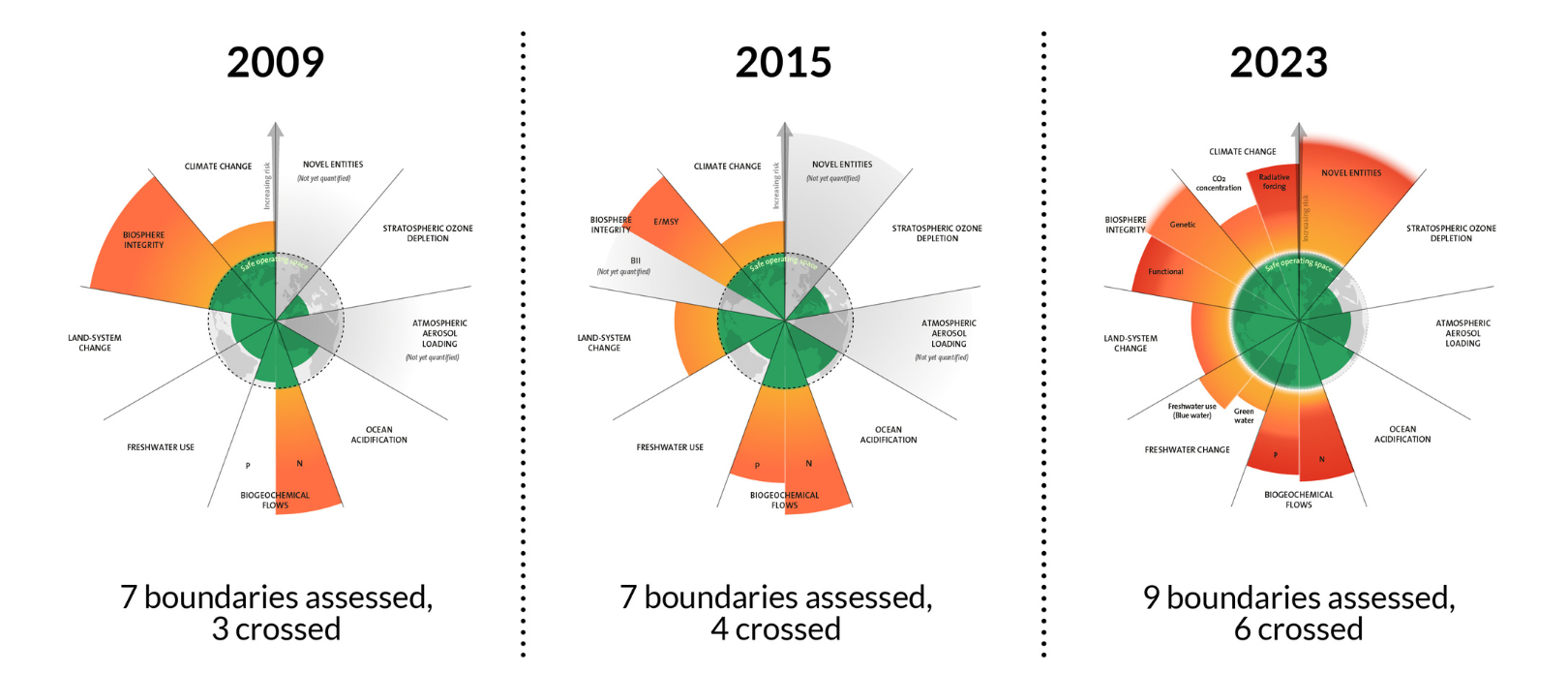Acknowledging the Anthropocene
Image Source: WikiMedia Commons
From China’s Golden Age to Brat Summer, humanity loves labels. We brand every new discovery, era, or invention as if it's a product on a shelf. Our planet, however, has been quietly labeling itself for the last 4.5 billion years, defining epochs with shifts in climate, biological diversity, and big cosmic events. Two such labels—the Holocene and the Anthropocene—are of particular interest when discussing climate change, planetary boundaries, and what sustainability really means.
Let's dive into this Earth-marketing department's work, shall we?
Holocene: A Golden Age of Calm
The Holocene epoch, which began around 11,700 years ago, is what scientists call a "post-glacial" period. In simpler terms, for my Game of Thrones fans, it's the Earth saying, "Summer is coming."
The planet warmed up, glaciers retreated, and humanity decided this was the perfect time to invent agriculture and start settling down. Most of what we call "human history" happens in the Holocene—think Egyptian pyramids, the Roman Empire, and basically most of what’s mentioned in The Big Bang Theory title song.
Geologists define epochs by looking at significant changes in Earth’s systems: climate, geology, and biology. The Holocene is characterized by a relatively stable climate, compared to the Pleistocene, which allowed human civilization to flourish. No crazy temperature swings, no mass extinctions—just a nice, steady run of temperate weather (although volcanoes, hurricanes, tsunamis, etc. occasionally tried to ruin the party). This climate stability gave rise to everything we associate with human development: cities, industrial revolutions, and even your Wi-Fi connection.
But like all good things, stability couldn't last forever.
Anthropocene: Humans, The Earth’s Newest Geological Force
Fast forward to the present day, and you might notice that humanity has been stirring the geological pot a bit too vigorously. Enter the Anthropocene, a proposed new epoch. Unlike previous epochs, which were triggered by natural events like asteroid impacts or massive volcanic eruptions, this one is all about us—humans.
The term Anthropocene was popularized by Nobel Prize-winning atmospheric chemist Paul Crutzen in the year 2000. It suggests that human activities have become the dominant force shaping the Earth, from carbon emissions to plastic pollution and massive deforestation. According to this idea, we've nudged the planet into a new phase where the effects of human activity will be visible in the rock layers for millions of years.
The Anthropocene is characterized by:
Rising CO2 levels: Thanks to fossil fuel burning, the atmosphere hasn't seen CO2 concentrations this high for at least 800,000 years. (Remember the Industrial Revolution? Yeah, this is its unfortunate legacy.)
Biodiversity loss: Experts say we're losing species at 100 to 1,000 times the background extinction rate. It's as if we're hosting an involuntary planetary game of "Survivor," and nature is the one getting voted off the island.
Plastic and pollution: Look in any ocean or field, and you're likely to find microplastics, evidence of our brief obsession with single-use convenience.
Some scientists still debate whether we should officially declare the Anthropocene. The Holocene’s geological stability was kind of nice, but we’ve clearly changed the planet in a way that’s impossible to ignore.
Planetary Boundaries: The Earth's Warning Lights
If the Anthropocene is our new epoch, then planetary boundaries are the warning lights on our metaphorical dashboard. In 2009, a team led by Swedish scientist Johan Rockström introduced the concept of nine planetary boundaries. These are thresholds we shouldn't cross if we want to maintain a stable Earth system similar to the Holocene.
The nine boundaries are:
Climate Change
Biosphere identity (biodiversity loss)
Biogeochemical Flows (nitrogen and phosphorus cycles)
Ocean Acidification
Land System Change
Freshwater Use
Ozone Depletion
Atmospheric Aerosol Loading (particulate pollution)
Novel Entities (things like plastics and chemicals)
Of these nine, scientists believe we’ve already exceeded SIX: climate change, biodiversity loss, biogeochemical flows, land system change, freshwater use, and novel entities. This is like driving a car and seeing multiple “check engine” lights blinking. The Anthropocene may not kill the engine, but those dashboard lights suggest we might be heading toward uncharted, and likely dangerous, climatic territory.
Climate Change: The Anthropocene’s Biggest Party Crasher
If we had to pick one defining characteristic of the Anthropocene, it would probably be climate change. Sure, the planet's climate has fluctuated throughout history, but the current pace of change is what's truly alarming (a.k.a The Great Acceleration). Human activities—primarily the burning of fossil fuels—have increased global temperatures by 1.1°C since the late 19th century .
That may not sound like much, but even a small change in average temperature can have enormous consequences. We're already seeing more extreme weather events, shifting agricultural patterns, rising sea levels, and melting glaciers. It's a bit like leaving the air conditioning on too long—you don't notice it at first, but eventually, you’re sitting in an icebox.
What Does Sustainability Actually Mean?
So, where does sustainability come in? Given that we’re flirting with multiple planetary boundaries, sustainability has evolved into something more than just recycling or bringing reusable bags to the grocery store (though that’s still great!).
In the Anthropocene, sustainability means:
Reducing CO2 emissions and transitioning to renewable energy sources to mitigate climate change.
Preserving biodiversity by protecting ecosystems and the services they provide.
Creating a circular economy, where we minimize waste and keep resources in use for as long as possible.
Sustainability is no longer just a nice-to-have goal but a survival strategy. It’s about living within the planet’s limits, respecting those planetary boundaries, and not pushing the Earth into a chaotic new state.
Can We Make It to the Next Epoch?
Warming periods have dramatically reshaped civilizations throughout history, from the Roman Empire's economic woes and the Maya's downfall amid droughts to the migration of the Ancestral Puebloans due to prolonged dry spells—each story a reminder of the urgent need for proactive measures in our climate crisis today.
The good news? Humans are a resourceful species. We've developed carbon-capturing technology, shifted toward renewable energy, and are making strides in areas like sustainable agriculture and biodiversity conservation. The challenge, however, lies in the scale and speed of these changes. The next few decades are critical: if we act now, we may avoid some of the worst outcomes of climate change and secure a more stable future for the planet.
In the end, epochs are long, and humanity’s story is still being written. Whether we all live to see the Anthropocene officially declared or some remain in the twilight of the Holocene depends largely on our collective actions in the coming years. So, let’s make it a good one. After all, no one wants to end up being just a footnote in a future geology textbook.
Sources:
Crutzen, P. J. (2002). "Geology of Mankind." Nature, 415(6867), 23.
Rockström, J., et al. (2009). "Planetary Boundaries: Exploring the Safe Operating Space for Humanity." Ecology and Society, 14(2): 32.
Steffen, W., et al. (2015). "The Trajectory of the Anthropocene: The Great Acceleration." The Anthropocene Review, 2(1), 81-98.
IPCC. (2021). "Sixth Assessment Report: Climate Change 2021.".



